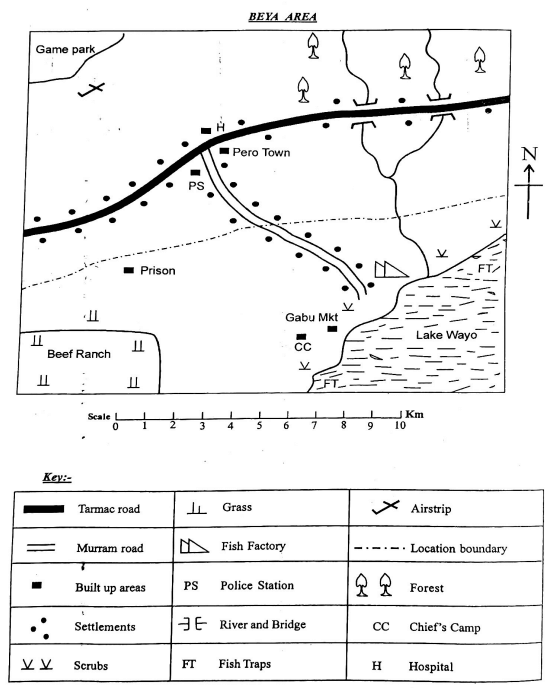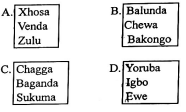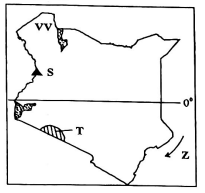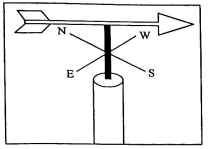
Use the map of Beya area to answer questions 1-7.
- The climate experienced around lake Wayo is
- hot and dry
- cool and wet
- hot and wet
- cool and dry.
- The approximate area of the beef ranch in square kilometres is
- 6.5km2
- 15.0km2
- 11.0km2
- 20.0km2
- The location of the fish factory was mainly influenced by
- availability of market for fish
- nearness to source of fish
- availability of means of transport
- nearness to source of land.
- Land in Beya area generally rises from
- North
- North East
- North West
- South.
- The most senior administrator in Beya area is
- Assistant County Commissioner
- Chief
- Deputy County Commissioner
- Governor.
- Which one of the following economic activities is not carried out in Beya area?
- Fishing.
- Lumbering.
- Livestock keeping.
- Tourism.
- Population distribution in Beya area is mainly influenced by
- fishing
- rainfall
- employment
- transport
- Before the coming of Europeans, skills in iron working were taught to learners through
- observation
- proverbs
- songs
- riddles.
- Which one of the following groups of communities is made up of Bantu speakers of Central Africa?
- Three of the following traditional weather observation methods indicate a wet season. Which one does not?
- Croaking of frogs.
- Excitement of cattle.
- Shedding of leaves.
- Dew on the grass.
- Which one of the following groups of items consist of cultural artefacts preserved in museums?
- Bows, arrows, spears.
- Gourds, calabashes, pots.
- Shields, swords, knives.
- Beads, bangles, earrings.
- Ox-bow lakes are formed through
- erosion
- deposition
- downwarping
- lava damming.
- Which one of the following statements is true about the Khoikhoi and the San people in the pre-colonial period?
- They lived in stone houses.
- They had hereditary chiefs.
- They lived a nomadic life.
- They were long distance traders.
- Which one of the following seaports is correctly matched with the country it is found?
Seaport- Durban - South Africa
- Lobito - Mozambique
- Beira - Namibia
- Walvis Bay - Angola
- Three of the following marriage systems in Kenya allow polygamy. Which one does not?
- Civil marriage.
- Customary marriage.
- Islamic marriage.
- Christian marriage.
- Below are statements about an ocean current;
- It flows from cold areas
- It causes fog and mist
- It affects climate of South West Coast of Africa
The Ocean current described above is- Canary current
- Agulhas current
- Benguela current
- Guinea current.
- Most Kenyans between 18 years and 35 years move to live in towns mainly to
- live with their relative
- look for employment
- escape idleness in rural areas
- join institutions of learning.
- The best method of transporting of medicine from India to Kenya is
- water
- railway
- air
- road.
- The main problem facing Perkerra Irrigation Scheme is
- inadequate water in the dry season
- decrease in farming land
- siltation of water canals
- pests that destroy crops.
- Which one of the following combinations consists of traditional African leaders who resisted European colonial rule?
- Lewanika and Mumia.
- Lenana and Waiyaki.
- Samouri and Lewanika.
- Mekatilili and Mkwawa.
- The purpose of a school motto is to
- show the direction to a school
- outline the aims of a school
- outline daily activities in a school
- show the number of pupils in a school.
- Three of the following are benefits of poultry farming. Which one is not?
- It is a source of income.
- It provides people with food.
- It attracts tourists.
- It is a source of farm manure.
- Below are characteristics of a relief region in Kenya;
- It lies between 1000 metres and 2000 metres
- It has few hills
- Some areas experience floods
The relief region described above is- Lake Victoria basin
- Rift Valley region
- Coastal lowlands
- Plateau region.
- Judy crosses a busy road when going to school. The safest way to cross the road is
- look right, look left, look right and cross the road
- tell the motorists to stop
- run across the road
- cross the road when it is clear.
- Pollution in major towns in Kenya can best be reduced through
- relocating industries to rural areas
- putting dustbins in industrial areas
- collecting garbage regularly
- arresting people who dump waste.
- The diagram below represents a fishing method
The best place for catching fish using the above method is- in swamps
- in the deep sea
- in fast flowing rivers
- near the seashore.
- Which one of the following groups is made up of communities who migrated to Kenya insearch of pasture?
- Luo, Taita, Pokomo.
- Ameru, Tugen, Abakuria.
- Maasai, Somali, Turkana.
- Abagusii, Mijikenda, Akamba.
- The main effect of deforestation is that leads to
- spread of deserts
- exploitation of minerals
- increase in agroforestry
- preservation of sources of rivers.
- Tourists who visit mount Kenya are mainly attracted by
- scenery
- pre-historic sites
- sports
- wildlife.
- The policy of assimilation used by the French to administer colonies failed because
- Africans resisted colonial rule
- France had few colonial administrators
- it was hard for Africans to adopt foreign culture
- the French did not want Africans to get assimilated.
- Three of the following statements about volcanic mountains in Eastern Africa are true. Which one is not?
- They are the highest.
- All of them have craters.
- Some of them have snow.
- Some lie on the floor of the Rift Valley.
- The main cause of conflict in pastoral farming areas in Kenya is
- religious differences
- inadequate security facilities
- high level of illiteracy
- competition for pasture.
- It is the responsibility of children in a family to
- take care of family property
- provide basic needs
- establish business opportunities
- pay school fees.
- Standard eight pupils visited a place where quarrying was taking place. The effect of mining they observed was
- smoke
- chemicals.
- mineral deposits
- open pits.
Use the map of Kenya below to answer questions 35 to 38
- Which one of the following language groups used the route marked Z during the migration period?
- Bantus.
- Semites.
- Cushites.
- Nilotes.
- The game park marked T is
- Maasai Mara
- Amboseli
- Tsavo
- Ruma
- The mountain marked S was formed through
- volcanicity
- folding
- faulting
- erosion.
- Natural vegetation in the area marked VV consists of
- evergreen forests
- short shrubs
- tall grass
- mangrove trees.
- An economic activity carried out in semi-desert areas is
- dairy farming
- fishing
- mining
- flower farming.
- The following are descriptions of an early visitor to Eastern Africa;
- He came to control the Coastal trade
- He made Zanzibar his capital
- He died in 1854
The person described above is- Carl Peters
- William Mackinon.
- David Livingstone.
- Seyyid Said.
- The bill of rights is found in which chapter of the constitution.
- Four.
- Six.
- Two.
- Five.
- Which one of the following factors leads to slow population growth?
- Improved healthcare.
- Increased food production.
- High mortality rate.
- Early marriages.
- Below are statements about a type of livestock farming;
- People migrate with their animals
- Large herds of livestock are kept
- Cattle, sheep and goats are kept
The type of livestock farming described above is- ranching
- poultry farming
- dairy farming
- pastoral farming
- The weather instrument shown below is used to measure
- strength of wind
- direction of wind
- speed of wind
- intensity of wind.
- Three of the following were positive effects of white settler farming. Which one is not?
- Introduction of new crops.
- Establishment of industries.
- Creation of native reserves.
- Growth of towns.
- Democracy can be practised in a school through the following ways except
- allowing pupils to make class rules
- encouraging pupils to take part in games
- allowing pupils to choose clubs
- allowing pupils to elect their leaders.
- The main export crop of Ethiopia is
- sugarcane
- sisal
- cotton
- coffee.
- Which one of the following early political associations was formed by Harry Thuku?
- Young Kikuyu Association.
- Kikuyu Central Association.
- Kenya African National Union.
- East African Association.
- Which one of the following factors undermines peace in the society?
- Dialogue.
- Transparency.
- Favouritism.
- Patriotism.
- The most effective way of controlling gulley erosion is
- constructing terraces
- building check dams
- planting grass
- planting cover crops.
- A similarity of the governments of Kenya and Swaziland is that
- there is a Prime Minister
- there are two houses of parliament
- there is an elected President
- there is multi-party democracy.
- A four year old boy whose nationality and parents are not known is found in Kenya. He becomes a Kenyan citizen by
- adoption
- naturalization
- registration
- birth.
- Which one of the following groups is made up of manufacturing industries?
- Banking, catering, vehicles.
- Flour, tourism, hotel.
- Steel, shoes, plastic.
- Printing, hairdressing, shoe shining.
- Net drifting is a method of fishing used to catch fish
- in the deep sea
- near the seashore
- in a swamp
- in fast flowing rivers.
- Which one of the following is a symbol of national unity?
- Constitution.
- Coat of arms.
- President.
- Parliament.
- Which one of the following combinations is made up of salty water lakes?
- Kyoga and Albert.
- Victoria and Rukwa.
- Tanganyika and Malawi.
- Bogoria and Elementaita.
- Who among the following is a member of the cabinet?
- Speaker.
- Governor.
- Senator.
- Deputy President.
- The main reason for the construction of the River Tana projects was to
- control flooding
- create a fishing ground
- generate electricity
- create an inland water way.
- In a school duties are assigned to teachers by
- head teacher
- deputy head teacher
- school chairperson
- head of department.
- The head of the judicial system in Kenya is
- Magistrate
- Chief Justice
- Attorney General
- Speaker.
SECTION B
CHRISTIAN RELIGIOUS EDUCATION
- When Adam and Eve realised that they had sinned in the garden of Eden they
- went out of the garden
- repented their sins
- cultivated the garden
- made clothes from leaves.
- A promise that God made to Abraham was that God would
- give him many descendants
- give him an everlasting kingdom
- give him a long life
- make him a priest.
- Jacob worked for a long time for Laban. The Christian virtue he demonstrated was
- patience
- honesty
- loyalty
- obedience.
- The main reason why Moses removed his shoes when God called him was that
- he wanted to show he was close to God
- he wanted to avoid God's punishment
- he wanted to obey God
- he was afraid of God.
- Which one of the following commandments teaches Christians to be faithful in marriage?
- 'Do not steal'
- 'Do not accuse anyone falsely'
- 'Do not commit adultery'
- 'Respect your father and mother'
- The relationship of Ruth and her mother-in- law Naomi teaches Christians the virtue of
- loyalty
- obedience
- patience
- honesty.
- The incident in which David killed Goliath teaches Christians to be
- loyal
- patient
- obedient
- courageous
- The wicked wife of King Ahab who planned the murder of Naboth was called
- Abigail
- Jezebel
- Merab
- Ruth.
- Prophet Daniel was thrown into a den of lions because
- the king hated him
- he was a slave
- he disobeyed the king's order
- he failed to interpret the king's dreams.
- When Angel Gabriel announced the birth of Jesus, Mary was living in
- Bethlehem
- Jericho
- Bethsaida
- Nazareth.
- Jesus was left in the temple when He was twelve years old because He wanted to
- obey his parents
- preach to the Jews
- be in His father's house
- perform miracles.
- When the devil took Jesus to the temple during His temptation, the devil told Jesus to
- jump down from the top of the temple
- change water into wine
- bow down and worship him
- change wine into water.
- The teaching of Jesus about our enemies was that we should
- not mix with them
- love them and treat them well
- seek revenge
- report them to the authorities.
- The parable of Jesus that teaches Christians to be humble in prayer is
- mustard seed
- unmerciful servant
- widow and the judge
- pharisee and tax collector.
- When Jesus changed water into wine, He had gone to Cana to
- attend the passover feast
- preach at the Synagogue
- attend a wedding
- visit his relatives.
- Jesus pointed out his betrayer when He was
- eating the last supper
- praying at the Garden of Gethsemane
- being led to the place of crucifixion
- being tried before the council.
- Jesus forgave the thief crucified with Him because
- He knew the thief
- the thief was innocent
- the thief came from Galilee
- the thief was repentant.
- On the day of pentecost the disciples of Jesus were able to
- heal many people
- speak in tongues
- catch many fish
- choose the deacons.
- A Christian virtue learnt from the story of Ananias and Sapphira is that they should be
- humble
- obedient
- honest
- repentant.
- Which one of the following groups is made up of books of History?
- Genesis, Exodus, Leviticus.
- Psalms, Proverbs, Job.
- Matthew, Mark, Luke.
- Esther, Joshua, Ruth.
- Which one of the following is a gift of the Holy Spirit?
- Joy.
- Patience.
- Peace.
- Faith.
- A common way of worship in both Christianity and traditional African communities is
- beating drums
- reading scriptures
- pouring libations
- offering animal sacrifices.
- In traditional African communities shrines are places where
- ancestors are buried
- sacrifices are offered
- initiation ceremonies are held
- trade is conducted.
- Dowry is paid in traditional African communities in order to
- seal a marriage
- please parents
- show the bride is good
- help the needy.
- The main duty of priests in traditional African communities is to
- treat diseases
- allocate land to people
- lead people in worship
- settle disputes.
- The best way for Christians to promote development in the country is by
- preaching the gospel
- visiting the sick
- establishing hospitals
- attending church services.
- Your deskmate does not want to share his textbook with you. The best action for you to take is to
- tell your parents to buy for you a book
- report to the class teacher
- move to another desk
- advise him on the value of sharing.
- Which one of the following statements describes intercession as an element of prayer?
- Praying for oneself.
- Praying for other people.
- Being humble in prayer.
- Seeking for forgiveness.
- A leisure activity practised in both Christianity and traditional African communities is
- reading scriptures
- singing in church
- visiting the needy
- watching Christian programmes.
- Pre-marital sex in Christianity is discouraged because
- it is misuse of sex
- it leads to teenage pregnancies
- it leads to break up of families
- it is a waste of resources.
SECTION B
ISLAMIC RELIGIOUS EDUCATION
- Which one of the following surahs emphasizes the kindness to orphans?
- Asr.
- Maun.
- Kauthar.
- Fiil.
- Which one of the following surahs narrates the favours of Allah to prophet Muhammad?
- Tiin.
- Qadr.
- Dhuha.
- Inshirah.
- Surah Al-Ikhalas emphasizes on
- knowledge
- Taqwa
- Ihsan
- Tawheed.
- Those people who neglect swalah are warned by surah
- Maun
- Talaq
- Naas
- Alaq.
- Surah Al-Humaza discourages muslims from
- piling of wealth
- mistreating orphans
- multipractise in business
- backbiting and slander.
- Which of the following angels brought wahy to prophet Mohammad?
- Jibril.
- Malik.
- Izrail.
- Ridhwan.
- Who among the following accompained prophet Mohammed (SAW) during migration to Medina?
- Uthman.
- Abubakar.
- Hamza.
- Ali.
- Patients and time are two themes mentioned in surah
- Bayyinah.
- Kauthar.
- Asr.
- Falaq.
- What should a muslim say when he sees something good?
- Alhamdullilah.
- Bismillah.
- Mashallah.
- Astaghfirullah.
- Which one of the following is not a virtue of fasting?
- Self discipline.
- Symphathy.
- Sacrifice.
- Lack of appetite.
- Which one of the following is not an attribute of Allah?
- Ar-Rahama.
- Al-Qudus.
- Al-Wadud.
- Al-Mustafa.
- Which of the following pillars of Islam was commanded during the month of Rajab?
- Saleh.
- Hajj.
- Shahada.
- Fasting.
- Who among the following was the youngest person to become a muslim?
- Hamza.
- Ali.
- Abubakar.
- Khadija.
- Which one of the following is not Ash-hurum?
- Muharam.
- Shaban.
- Rajab.
- Dhul Qaada.
- Which one of the following parts of udhu is washed first?
- Feet.
- Hair.
- Arms.
- Face.
- Which of the following prophets of Allah was commanded to slaughter his son?
- Ibrahim.
- Musa.
- Daud.
- Issa.
- Which one of the following is not a sunnah prayer?
- Dhuha.
- Fajr.
- Taraweh.
- Istisqai.
- Which one of the following marks the conclusion of swalah?
- Adhan.
- Jasla.
- Ruku.
- Salam.
- Which angel is responsible for blowing the trumpet?
- Jibril.
- Israfil.
- Izrail.
- Munkar.
- Qabila killed his brother mainly because of
- indiscipline
- jealousy
- kindness
- selfishness.
- Who among the following was the first wife of the prophet?
- Aisha
- Hafa.
- Maymuna.
- Khadija.
- The prophet's mosque was built in
- Madina
- Makkah
- Jerusalem
- Taif.
- Which of the following is the main reason why Allah created man and Jinn?
- To give birth.
- To take care of earth.
- To worship Him.
- To take care of each other.
- The following are pillars of Wudhu except
- uttering Bismillah
- observing the order
- washing the forehead
- washing the feet.
- A good muslim leader should have all these qualities except
- humility
- compassion
- treachery
- impartiality.
- The last rite done to a dead muslim is
- Dafan
- Janaza
- kafan
- ghusul.
- The following are pillars of Hajj except
- Ihram
- Tawaf
- Arafat.
- Miqat.
- According to the hadith of the prophet paradise lies under the feet of
- uncles
- mothers
- imams
- fathers.
- Which day of the week was the prophet born?
- Tuesday.
- Friday.
- Monday.
- Sunday.
- Who was the king of Yemen who wanted to destroy the holy Ka'abah?
- Abrah.
- Qarum.
- Negus.
- Jalut.
MARKING SCHEME
SOCIAL STUDIES
- A
- C
- B
- D
- A
- B
- D
- A
- B
- C
- D
- B
- C
- A
- D
- C
- B
- C
- A
- D
- B
- C
- A
- D
- A
- B
- C
- A
- A
- C
- B
- D
- A
- D
- B
- A
- A
- B
- C
- D
- A
- C
- D
- B
- C
- B
- D
- A
- C
- B
- B
- D
- C
- B
- B
- D
- D
- C
- A
- B
C.R.E
- D
- A
- A
- C
- C
- A
- D
- B
- C
- D
- C
- A
- B
- D
- C
- A
- D
- B
- C
- D
- D
- A
- B
- A
- C
- C
- D
- B
- C
- A
I.R.E
- B
- C
- D
- A
- D
- A
- B
- C
- C
- D
- D
- A
- B
- B
- D
- A
- B
- D
- B
- B
- D
- A
- C
- A
- C
- A
- D
- B
- C
- A
Join our whatsapp group for latest updates
Tap Here to Download for 30/-
Get on WhatsApp for 30/-
Download Social Studies and Religious Education Questions and Answers - KCPE 2023 Prediction Papers Set 2.
Tap Here to Download for 30/-
Get on WhatsApp for 30/-
Why download?
- ✔ To read offline at any time.
- ✔ To Print at your convenience
- ✔ Share Easily with Friends / Students





